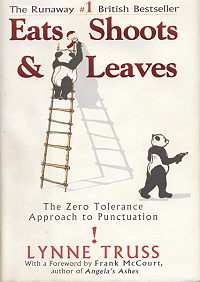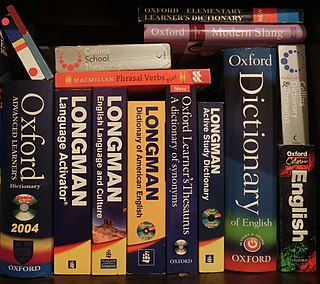Punctuation is the use of spacing, conventional signs and certain typographical devices as aids to the understanding and correct reading of handwritten and printed text whether read silently or aloud. Another description is, "It is the practice action or system of inserting points or other small marks into texts in order to aid interpretation; division of text into sentences, clauses, etc., by means of such marks."
The trivium is the lower division of the seven liberal arts and comprises grammar, logic, and rhetoric.
The comma is a punctuation mark that appears in several variants in different languages. It has the same shape as an apostrophe or single closing quotation mark in many typefaces, but it differs from them in being placed on the baseline of the text. Some typefaces render it as a small line, slightly curved or straight but inclined from the vertical, or with the appearance of a small, filled-in figure 9.
The colon is a punctuation mark consisting of two equally sized dots centered on the same vertical line. A colon precedes an explanation or an enumeration, or list. A colon is also used with ratios, titles and subtitles of books, city and publisher in bibliographies, biblical citations between chapter and verse, and for salutations in business letters and other formal letter writing, and often to separate hours and minutes.
The semicolon or semi colon (;) is a punctuation mark that separates major sentence elements. A semicolon can be used between two closely related independent clauses, provided they are not already joined by a coordinating conjunction. Semicolons can also be used in place of commas to separate items in a list, particularly when the elements of that list contain commas.
A comma is a type of punctuation mark.
In writing, a space is a blank area that separates words, sentences, syllables and other written or printed glyphs (characters). Conventions for spacing vary among languages, and in some languages the spacing rules are complex.
In English language punctuation, a serial comma or series comma is a comma placed immediately before the coordinating conjunction in a series of three or more terms. For example, a list of three countries might be punctuated either as "France, Italy, and Spain", or as "France, Italy and Spain".
In English grammar, a comma splice or comma fault is the use of a comma to join two independent clauses. For example:
It is nearly half past five, we cannot reach town before dark.

Eats, Shoots & Leaves: The Zero Tolerance Approach to Punctuation is a non-fiction book written by Lynne Truss, the former host of BBC Radio 4's Cutting a Dash programme. In the book, published in 2003, Truss bemoans the state of punctuation in the United Kingdom and the United States and describes how rules are being relaxed in today's society. Her goal is to remind readers of the importance of punctuation in the English language by mixing humour and instruction.

Accentus is a style of church music that emphasizes spoken word. It is often contrasted with concentus, an alternative style that emphasizes harmony. The terms accentus and concentus were probably introduced by Andreas Ornithoparchus in his Musicae Activae Micrologus, Leipzig, 1517. "Concentus might be chief ruler over all things that are sung...and Accentus over all things that are read," according to Ornithoparchus. The style is also known as liturgical recitative, though it differs in some important ways from other types of recitative.
Geʽez, also known as Ethiopic, is a script used as an abugida (alphasyllabary) for several languages of Eritrea and Ethiopia. It originated as an abjad and was first used to write Geʽez, now the liturgical language of the Eritrean Orthodox Tewahedo Church, the Ethiopian Orthodox Tewahedo Church, and Beta Israel, the Jewish community in Ethiopia. In Amharic and Tigrinya, the script is often called fidäl (ፊደል), meaning "script" or "alphabet".
Object Query Language (OQL) is a query language standard for object-oriented databases modeled after SQL. OQL was developed by the Object Data Management Group (ODMG). Because of its overall complexity nobody has ever fully implemented the complete OQL. OQL has influenced the design of some of the newer query languages like JDOQL and EJB QL, but they can't be considered as different flavors of OQL.
The full point, full stop or period is a punctuation mark. It is used for several purposes, the most frequent of which is to mark the end of a declaratory sentence ; this sentence-terminal use is properly, or the precise meaning of, full stop.
Declamation is an artistic form of public speaking. It is a dramatic oration designed to present through articulation, emphasis and gesture the full sense of the message being imparted.
John Richard "Jaś" Elsner, is a British art historian and classicist, who in 2013 was Humfry Payne Senior Research Fellow in Classical Archaeology and Art at the University of Oxford, based at Corpus Christi College, and Visiting Professor of Art History at the University of Chicago. He is mainly known for his work on Roman art, including Late Antiquity and Byzantine art, as well as the historiography of art history, and is a prolific writer on these and other topics. Elsner has been described as "one of the most well-known figures in the field of ancient art history, respected for his notable erudition, extensive range of interests and expertise, his continuing productivity, and above all, for the originality of his mind", and by Shadi Bartsch, a colleague at Chicago, as "the predominant contemporary scholar of the relationship between classical art and ancient subjectivity".


